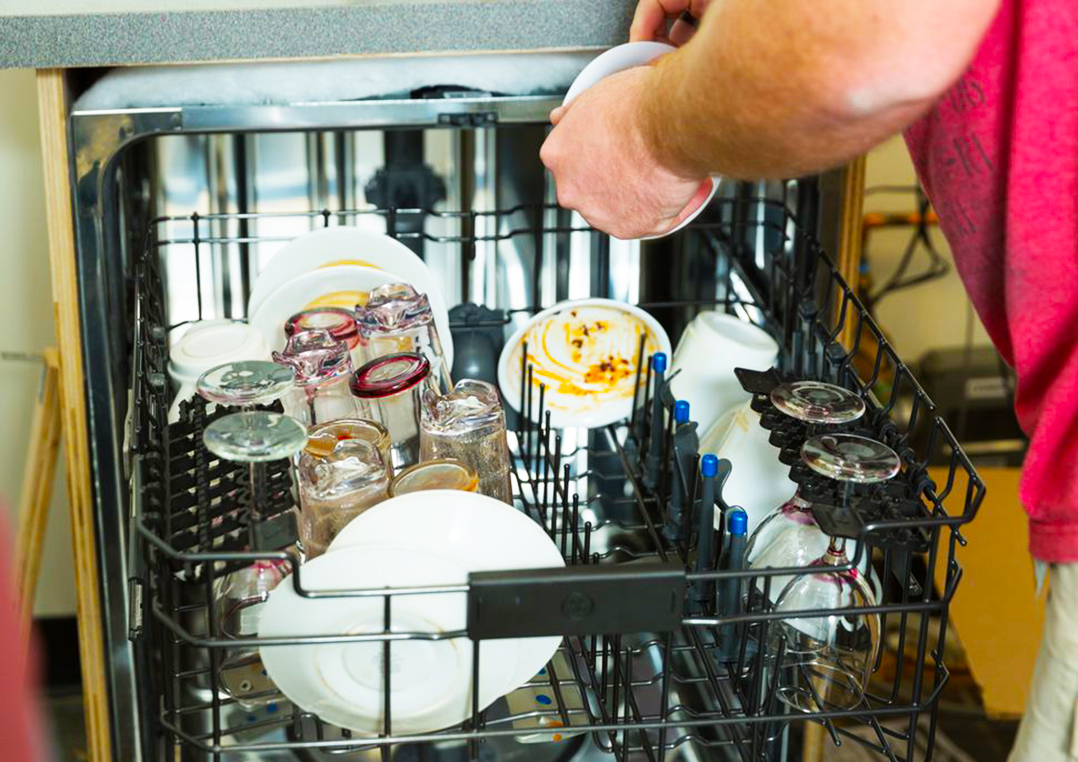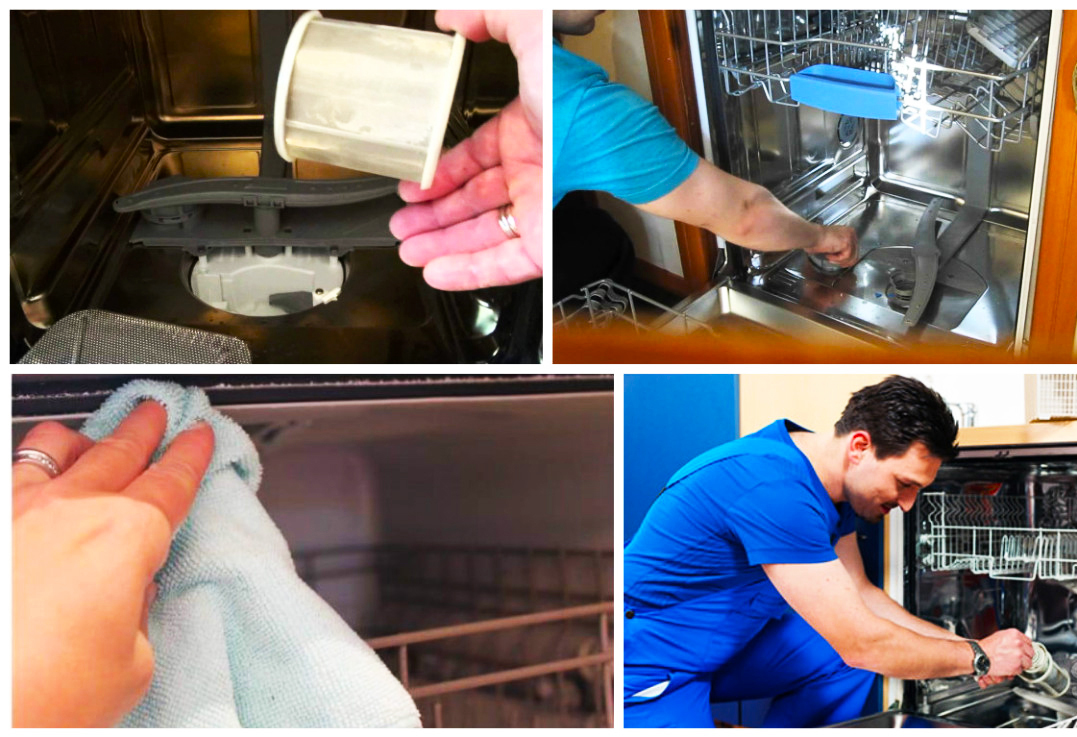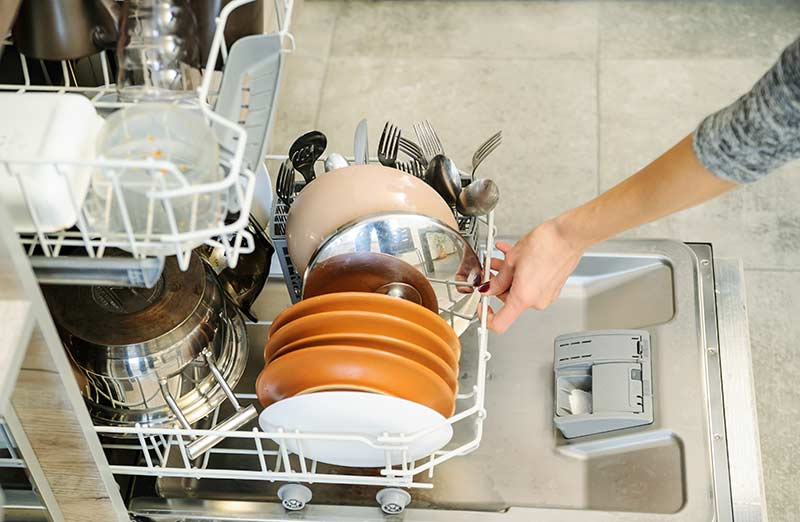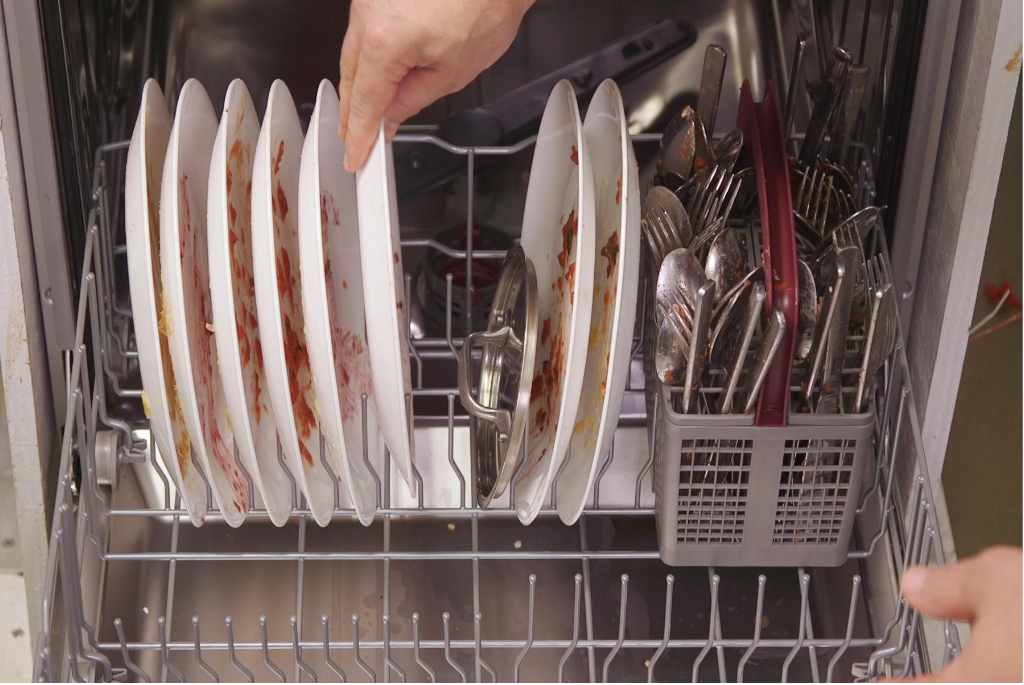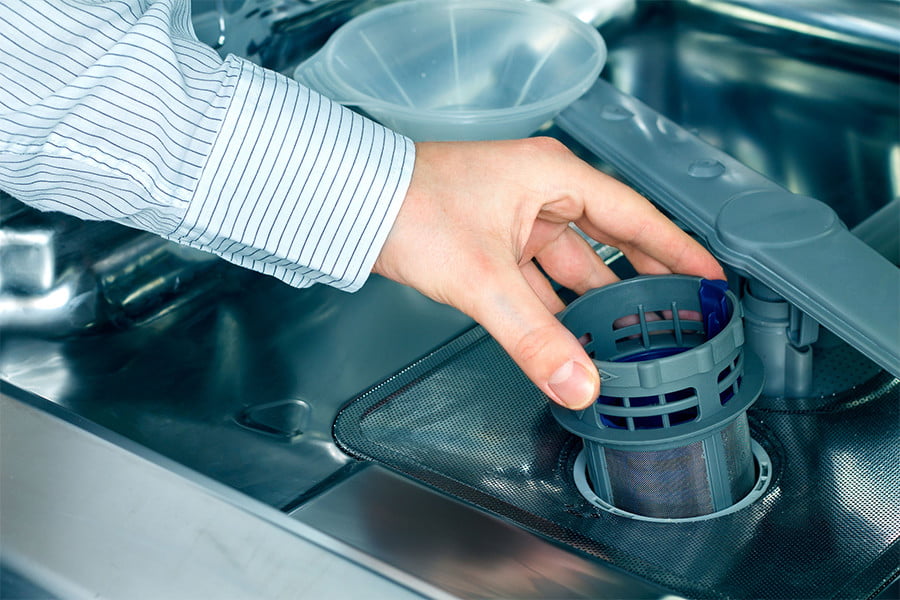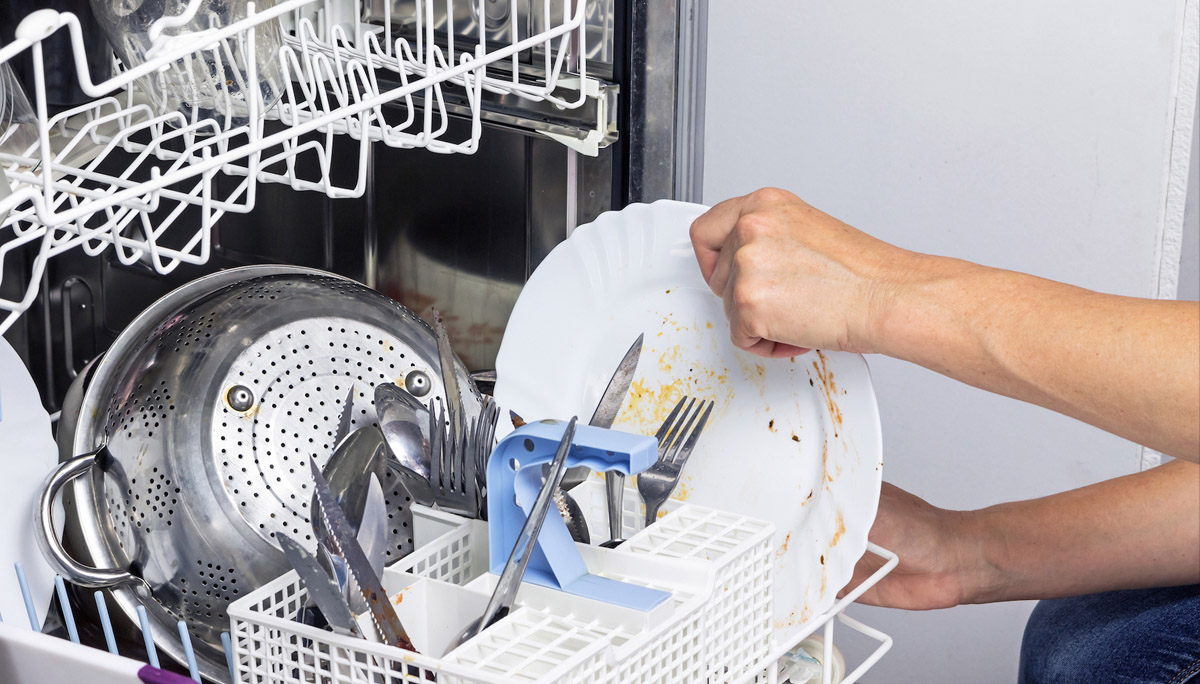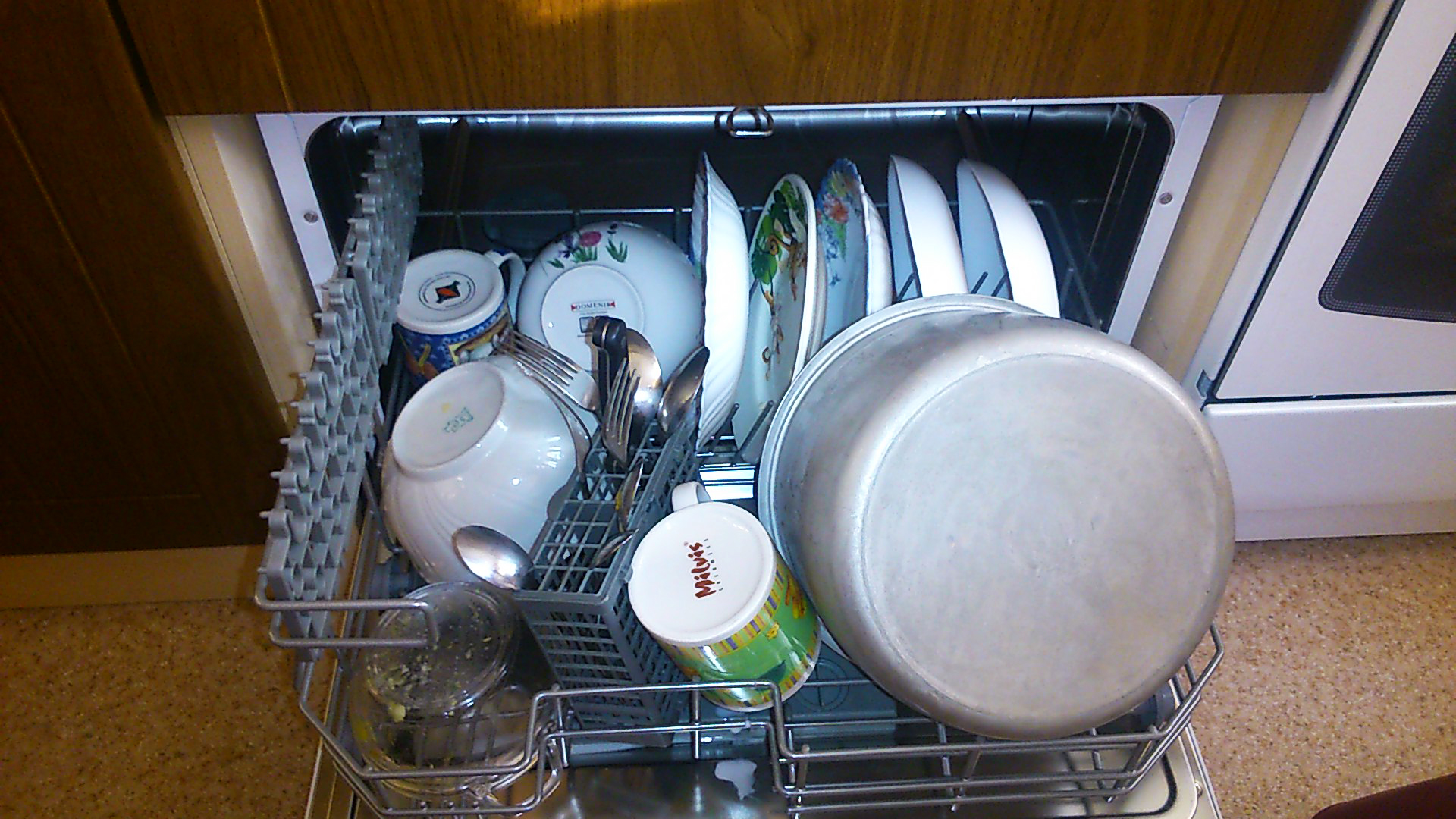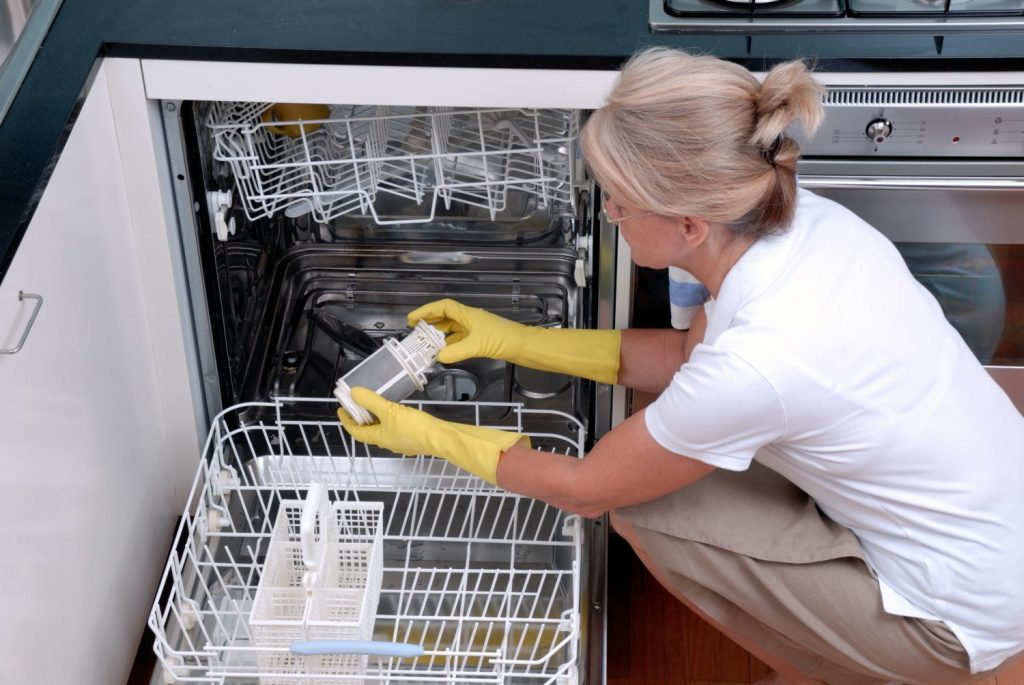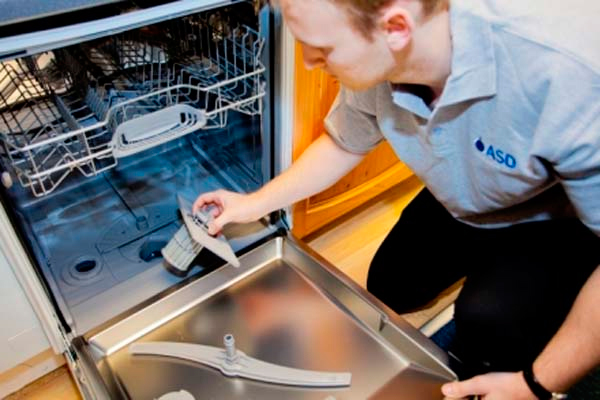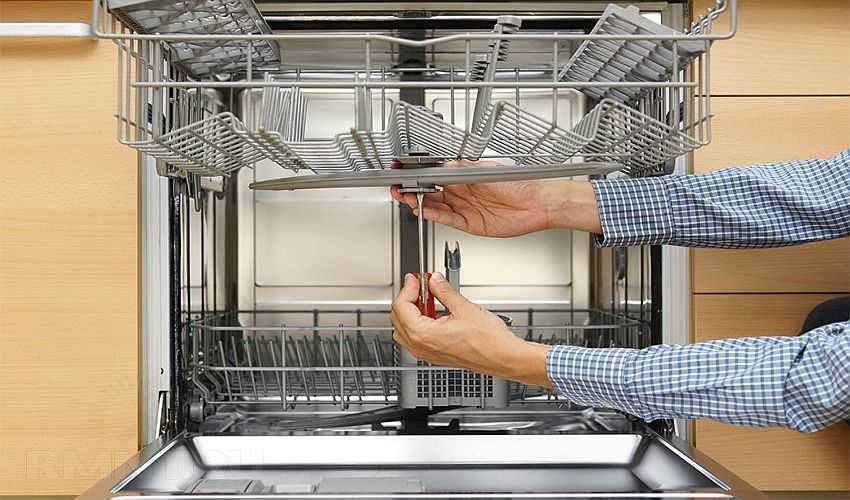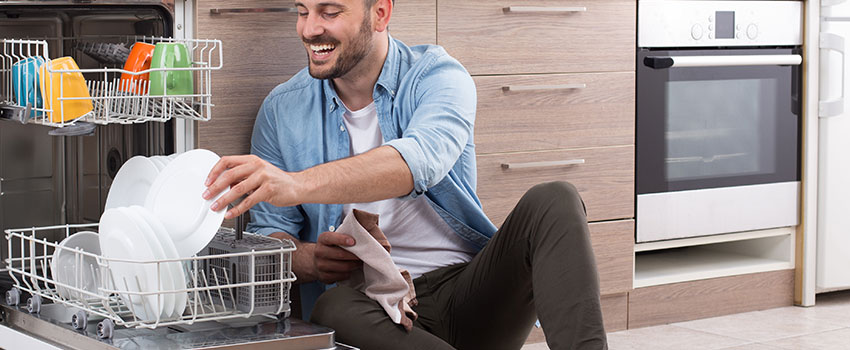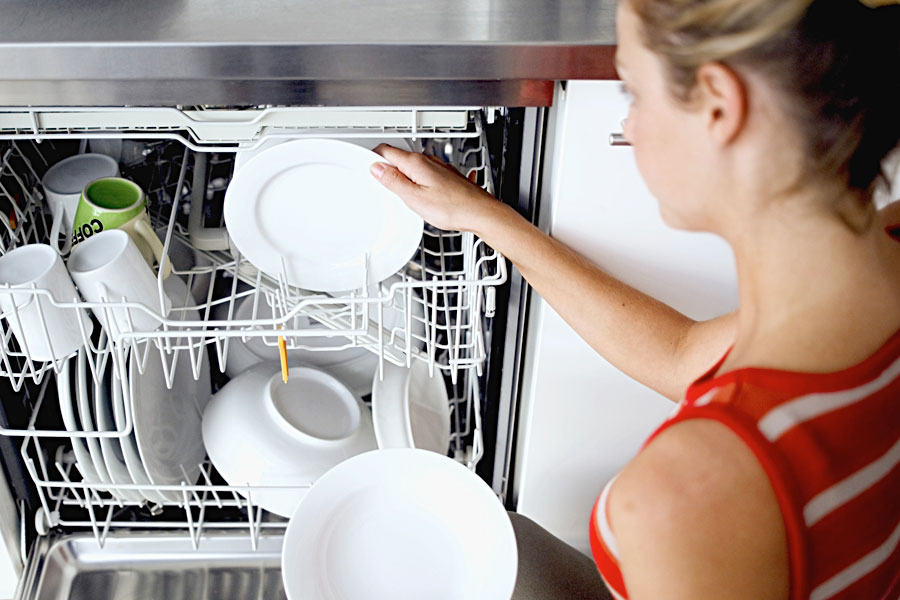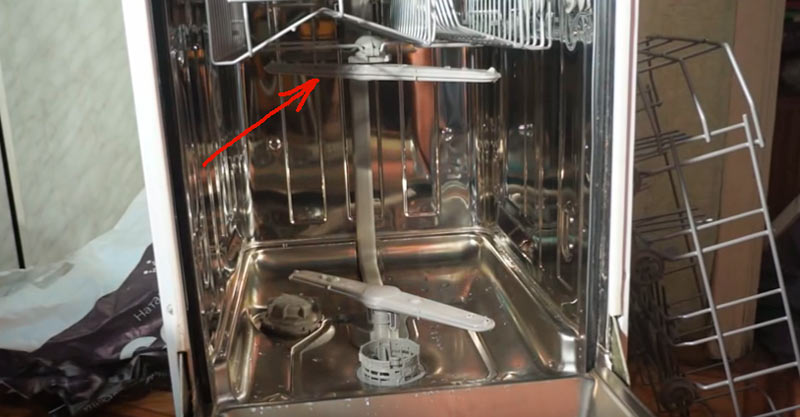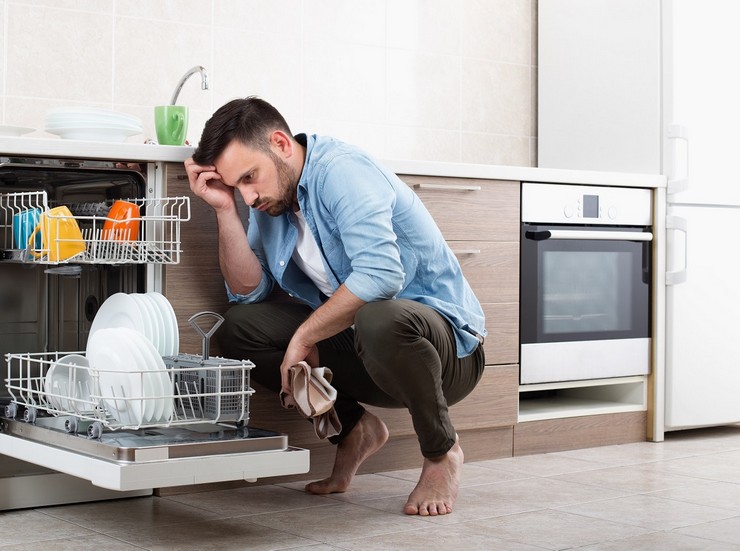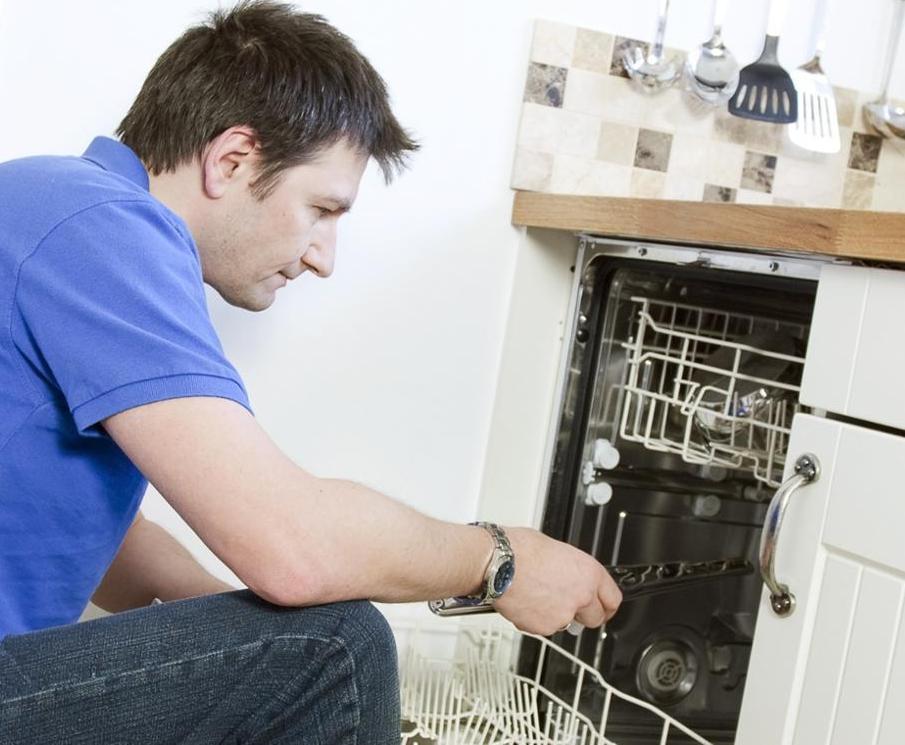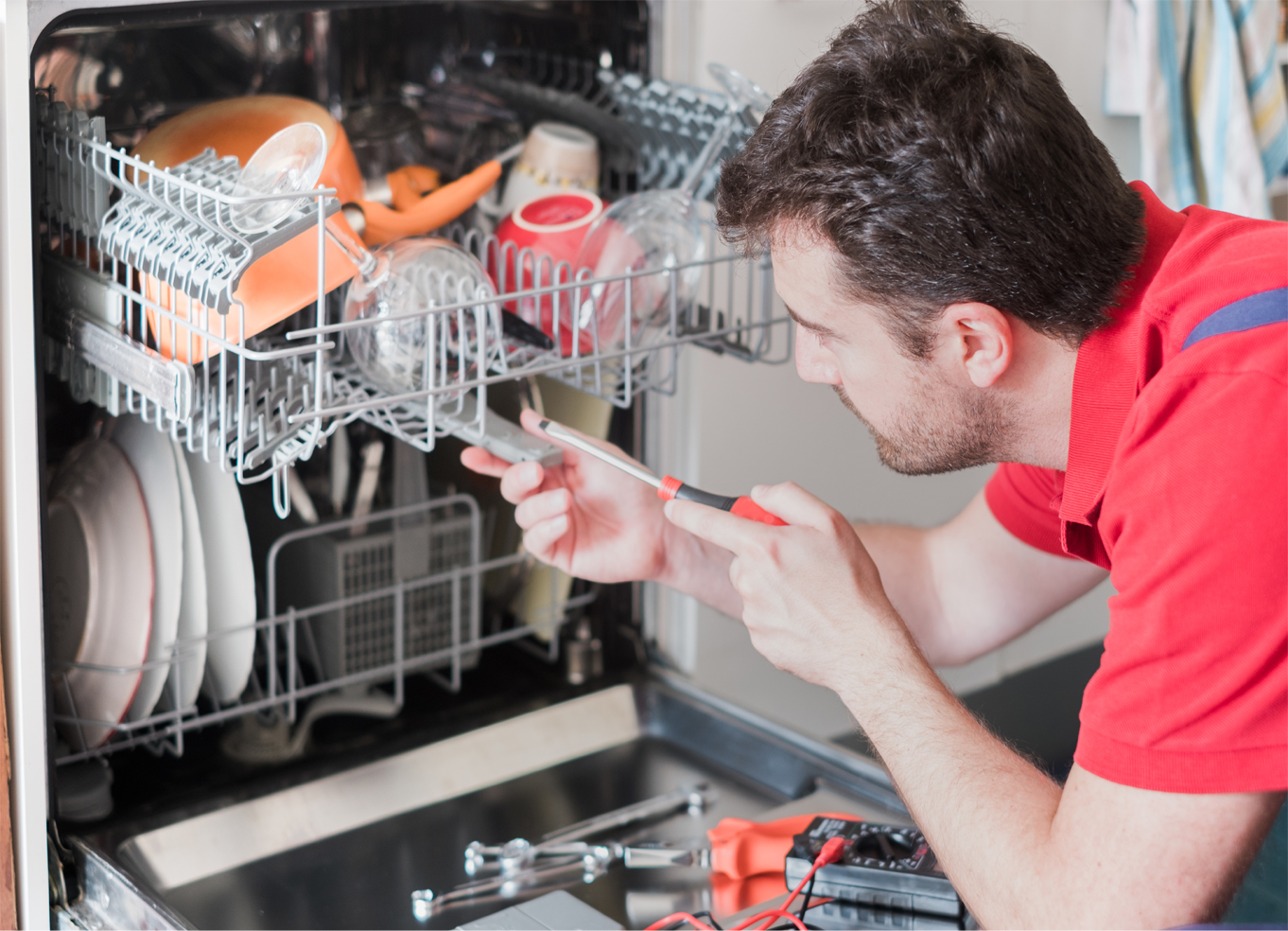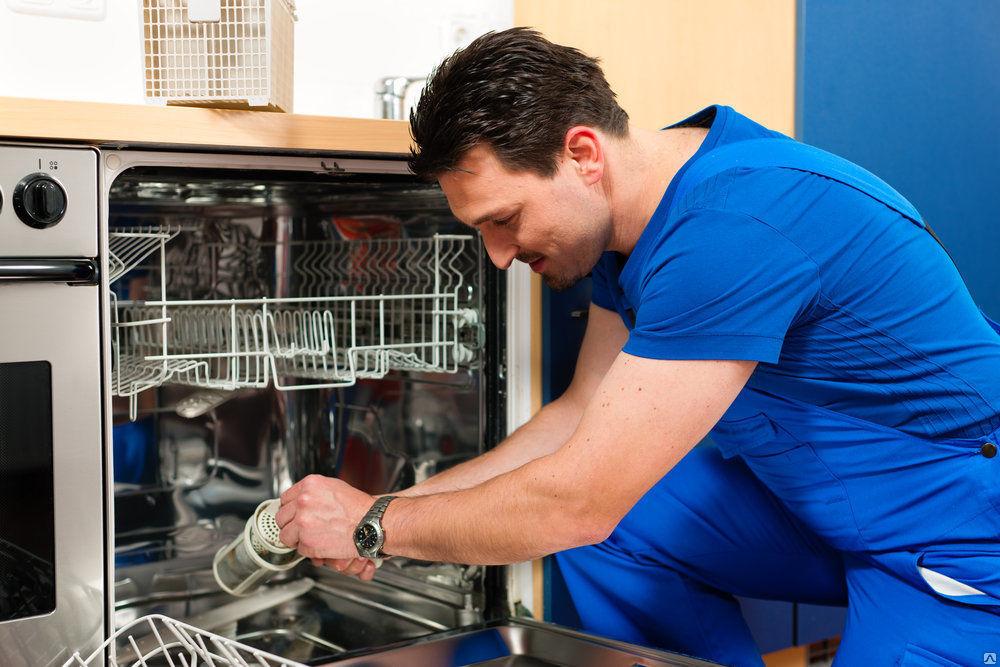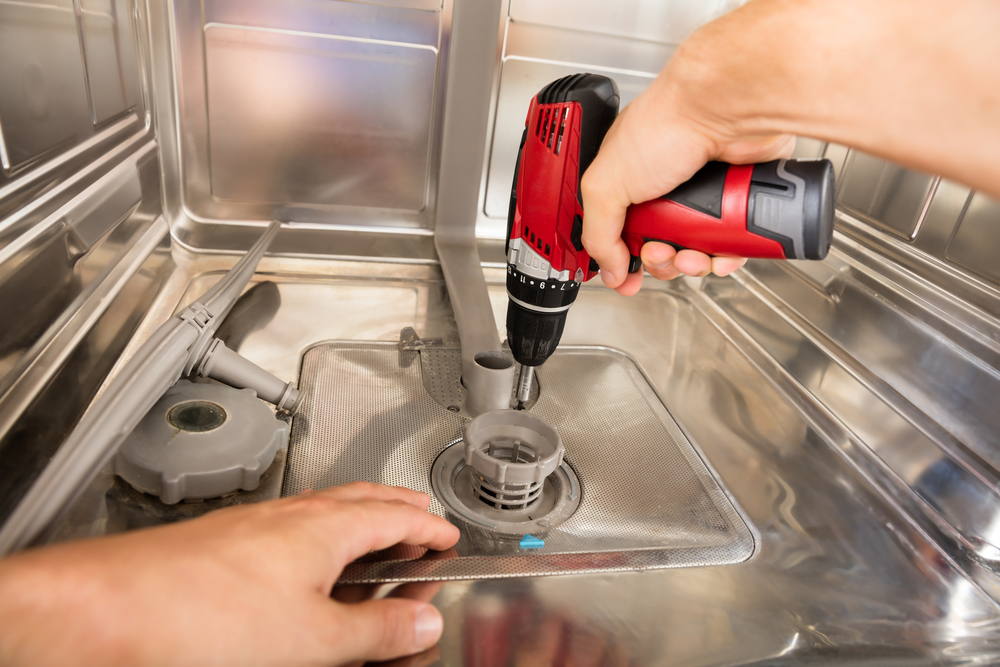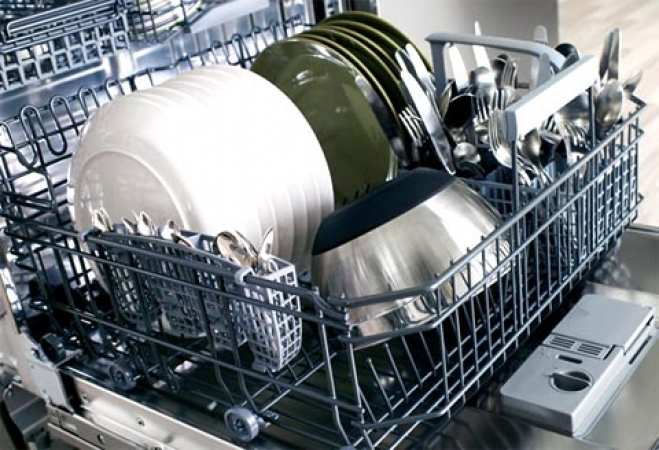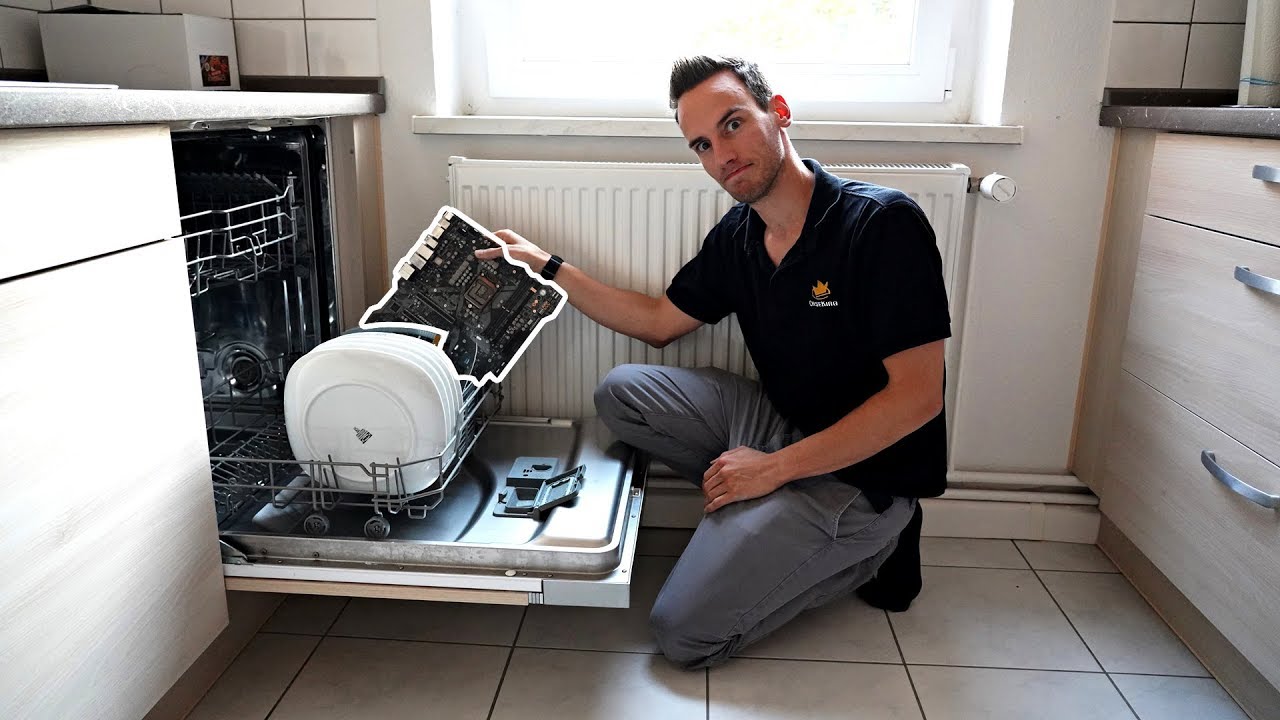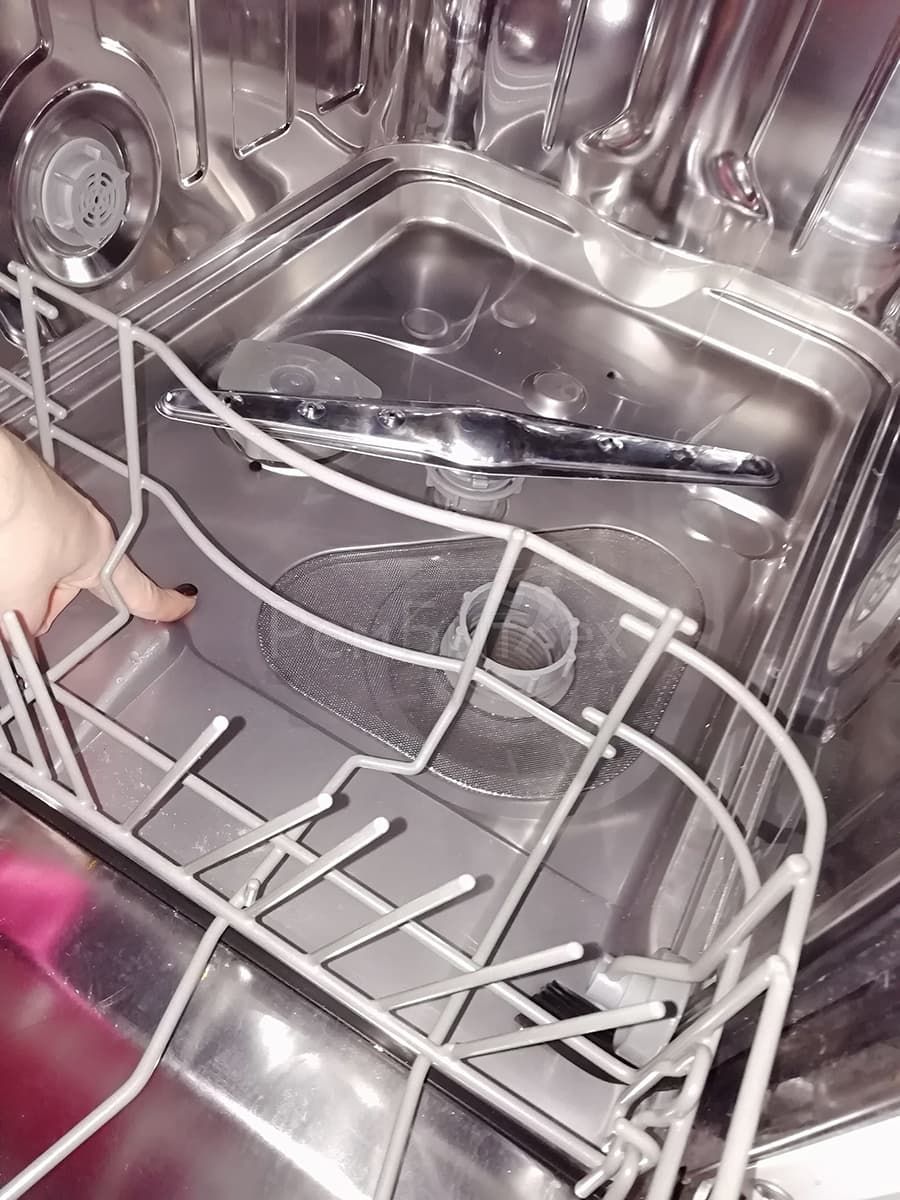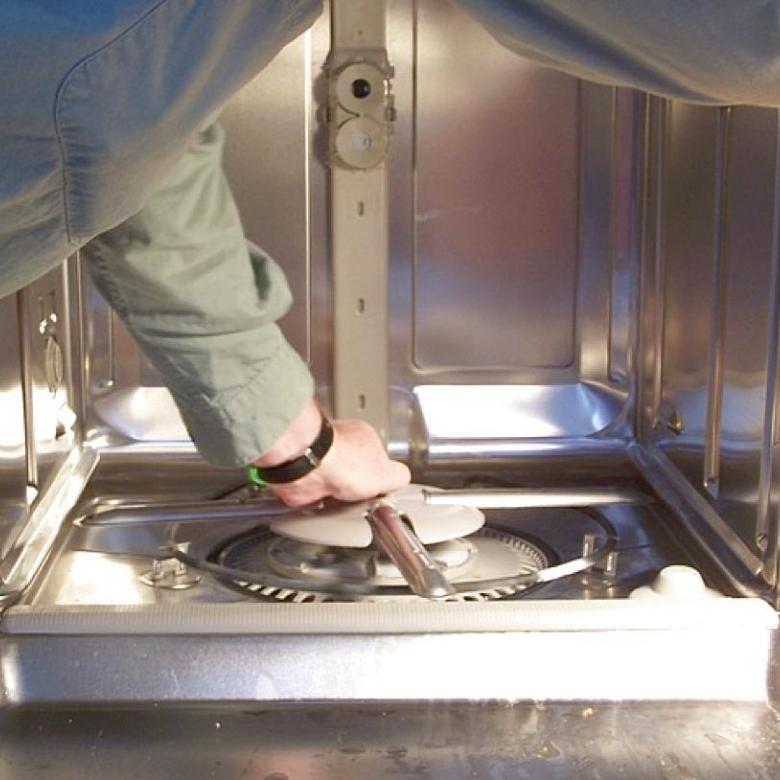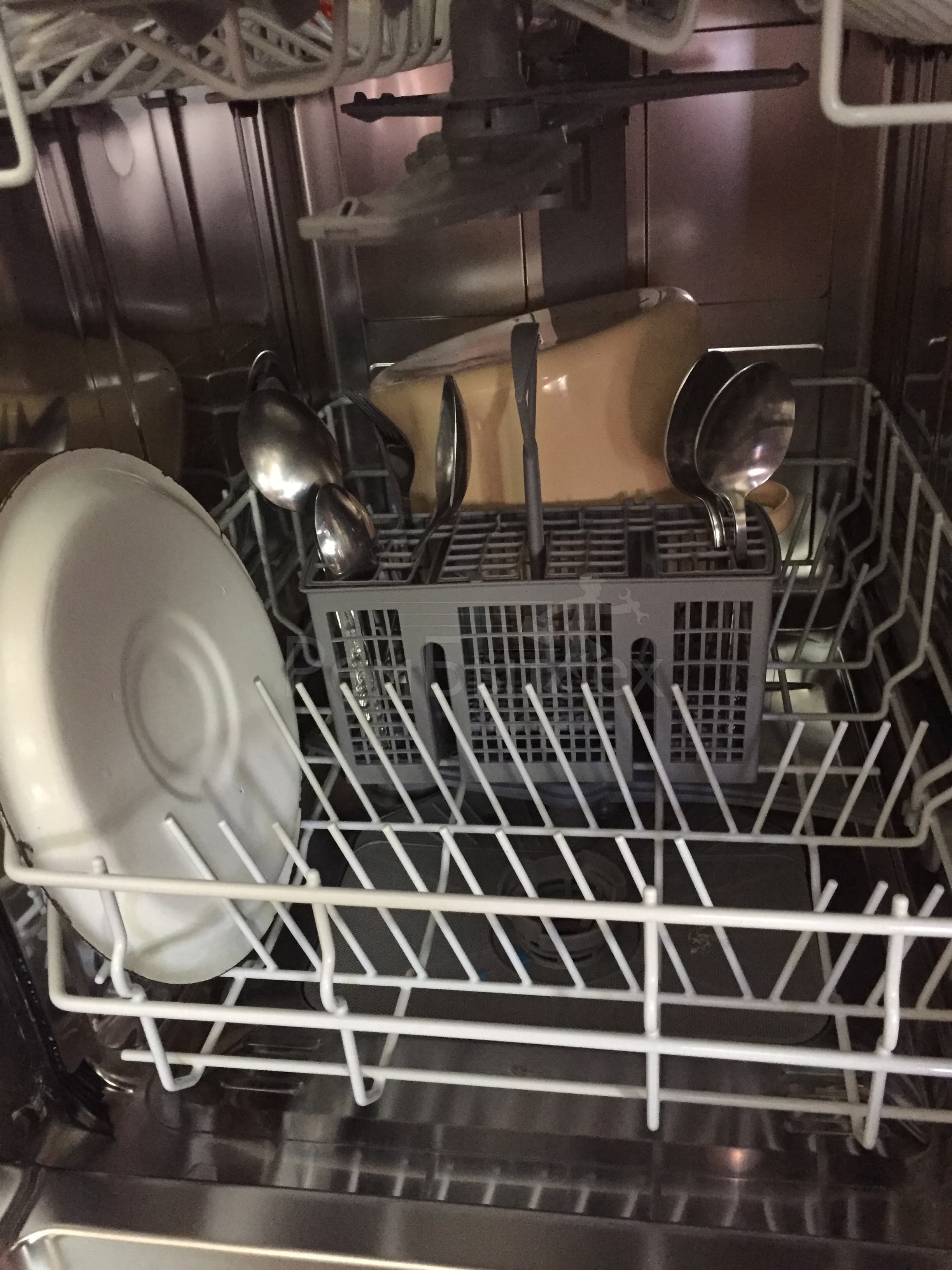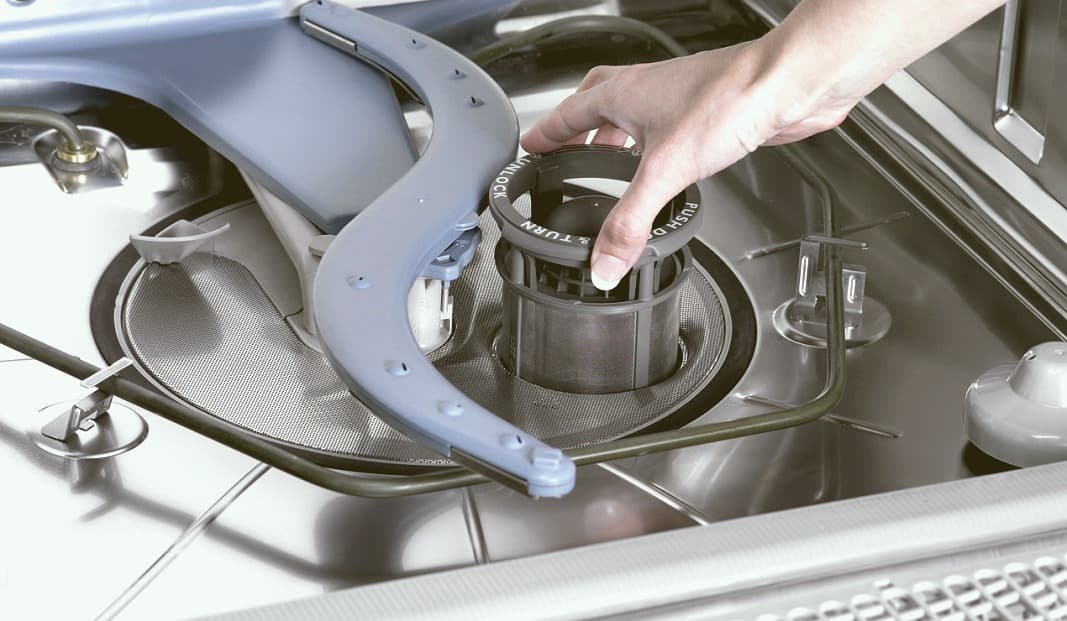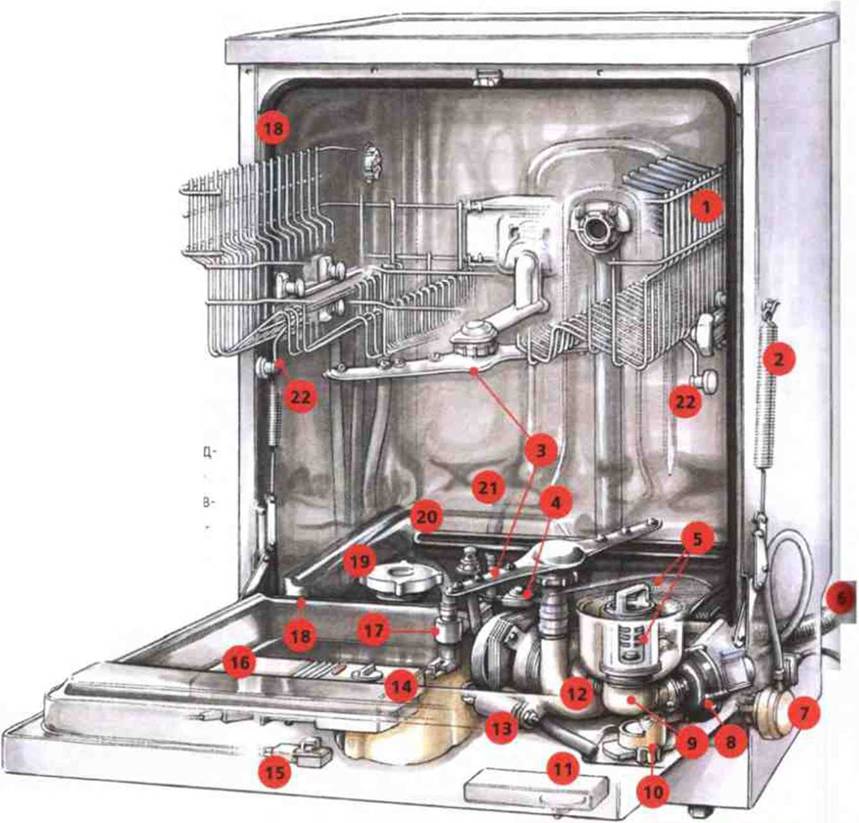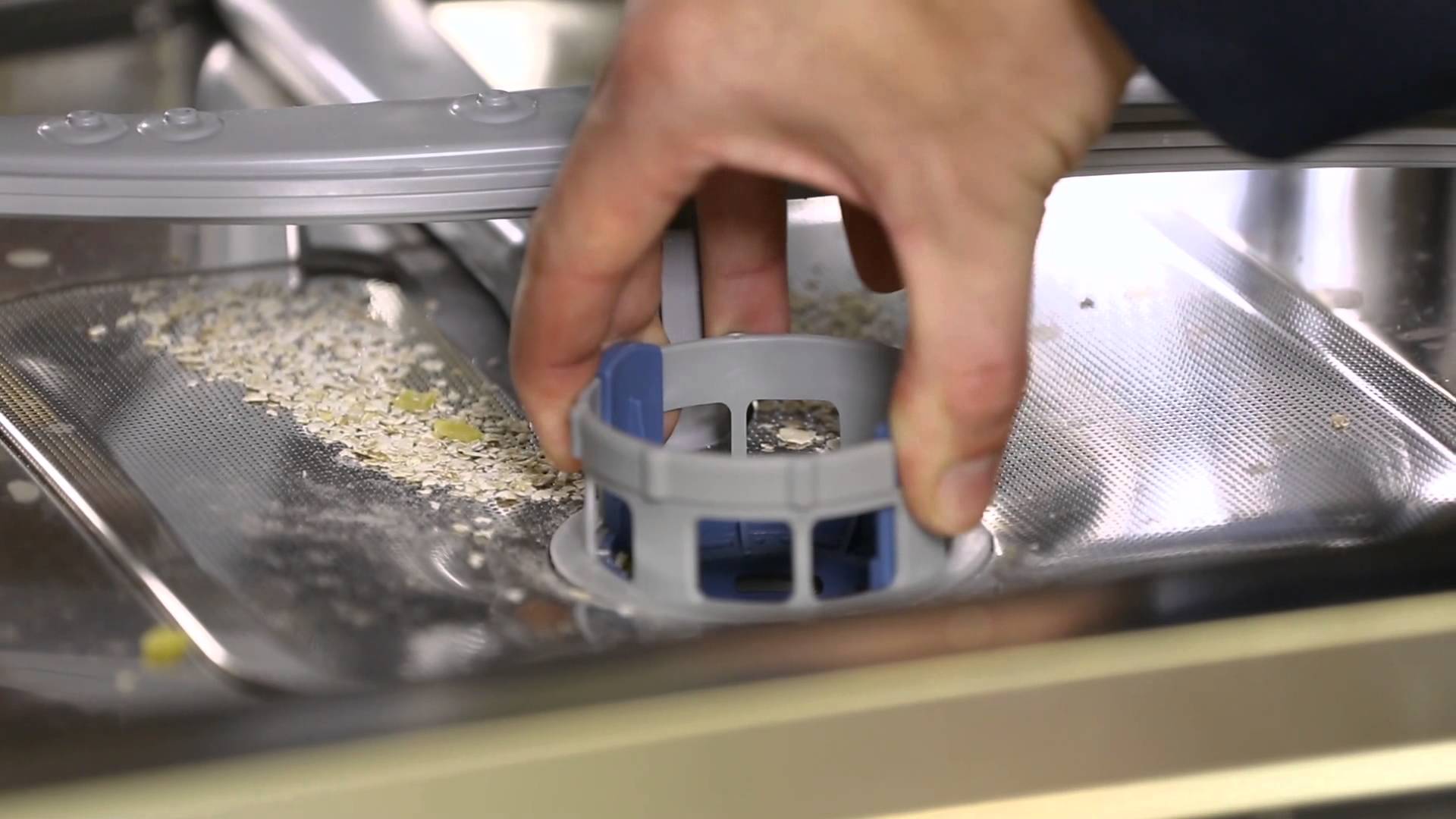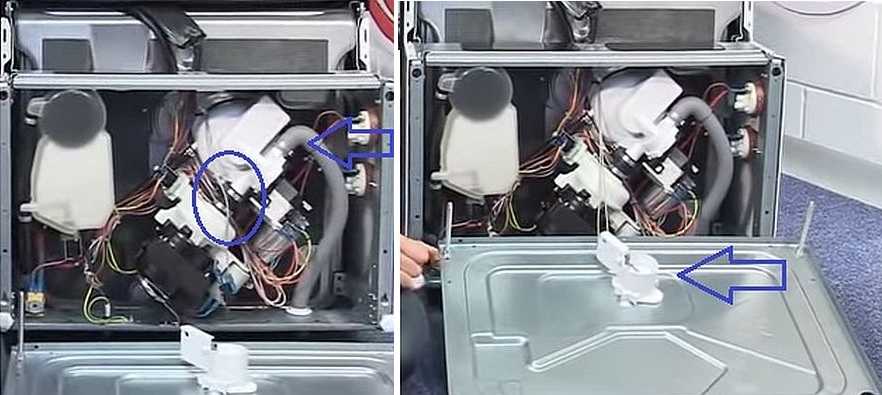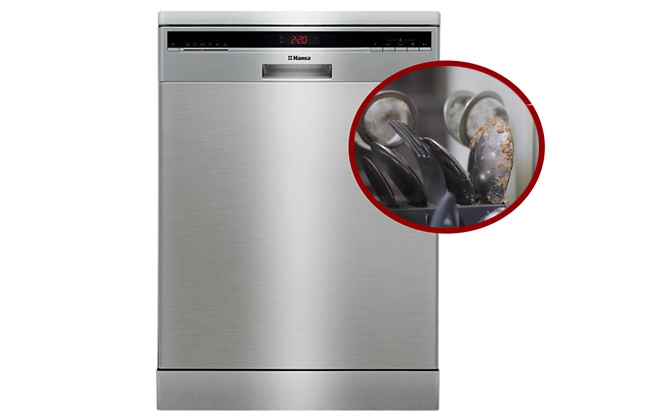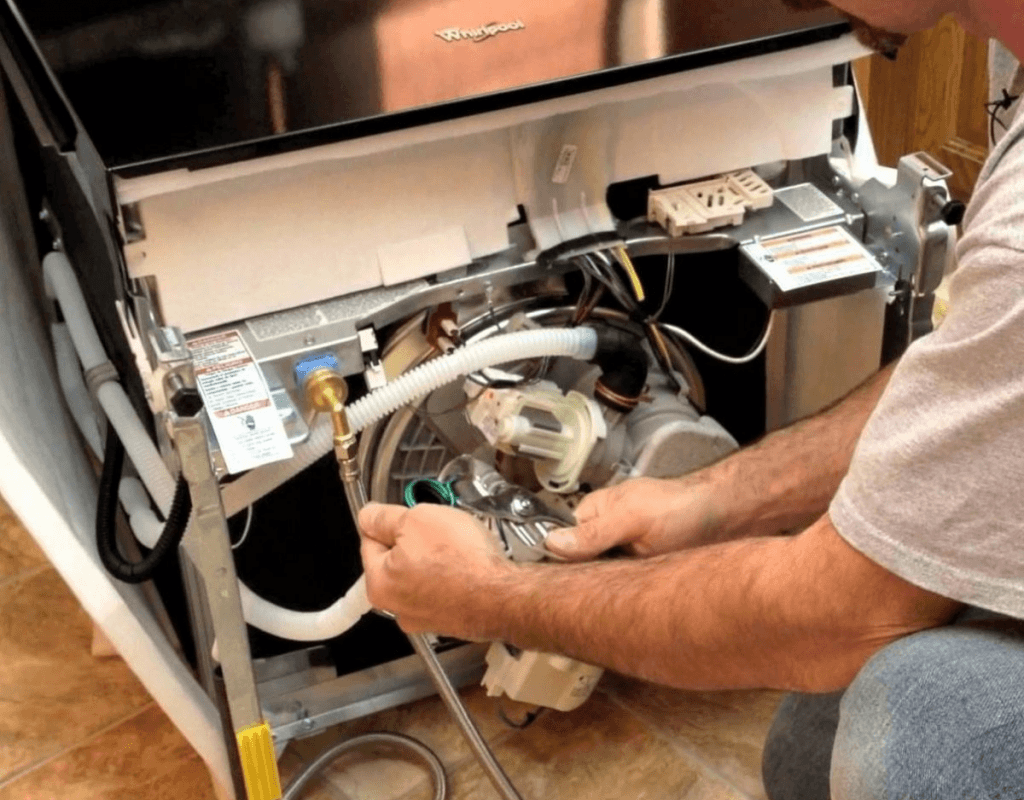The most common reasons for poor cleaning of dishes in specialized equipment: how to eliminate them?
If after cleaning in dishwashers from Bosch, Electrolux or other brands, stains, food debris or other contamination remain on the cutlery, then we can talk about both serious malfunctions of the unit and completely removable defects.
If the question arises as to why the dishwasher does not wash dishes well, then most often we can talk about completely banal reasons:
The presence of dried food and significant food debris. If you do not remove all this from the cutlery in advance, then you should not even count on the perfect cleaning of the dishes. This rule is mandatory for all manufacturers, both Bosch and others. Therefore, it should be observed in the first place.
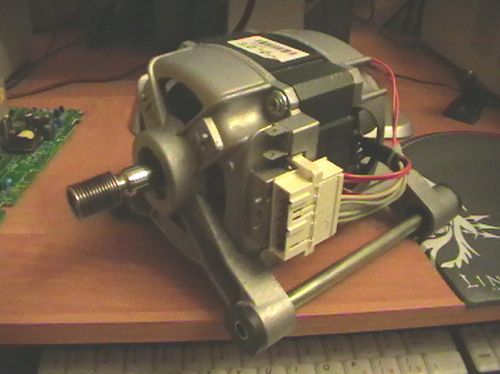
- Incorrectly selected mode of operation of the unit. Dishwasher programs that are too short or economical are only intended for light soiling. But dishes with greasy residues need to use a higher temperature regime and a long washing cycle.
- Significant overload of equipment. The dishwasher may not cope with its main task due to the installation of more dishes in it than is provided by the manufacturer. The next time you wash it, you should try to load fewer appliances into the appliance. Insufficient cleaning from the top can also be caused by improper loading of kitchen utensils. Incorrectly positioned devices can interfere with the functioning of important technical elements. In this case, you will need to reboot the equipment in accordance with the manufacturer's recommendations, as shown in the photo.
- If the unit does not wash the dishes well, then the reason for this may be an incorrectly selected or poor-quality detergent composition. In this case, the situation will be corrected by changing the means or using a smaller amount. Today there is a huge number of specialized products that are specifically designed for use in dishwashers. These can be both liquid gels and rinses, and multifunctional tablets.
For what other reasons does the technique fail to cope with its tasks?
Frequent and prolonged use of the dishwasher can also cause it to malfunction. In this case, the equipment may malfunction due to more serious malfunctions:
Scale build-up on the machine. This process is especially insidious for any dishwasher equipment. Scale may appear due to the increased hardness of the water used for washing (and this even with the constant use of special softening compounds). It is almost impossible to determine its presence on the plastic elements of the device, however, all internal metal parts with prolonged use begin to become covered with such a dangerous coating. After hitting the spray arm, the scale prevents the water from spraying properly, which in turn leads to poor cleaning of the cutlery. To correct this deficiency, you will need to add citric acid to the dishwasher instead of the usual cleaner, after which it starts at maximum temperature in idle mode.
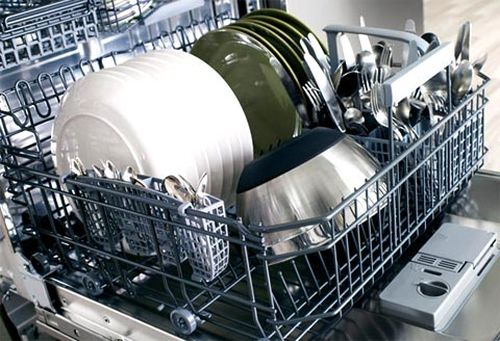
The appearance of blockages. If the Bosch dishwasher does not wash the dishes well, food particles, stains and other contaminants constantly remain on it, then we can talk about the formation of blockages in the technique. Most often, this problem occurs with fine filters, as well as coarse filters. If this is the case, then it is worth checking the condition of the filter first.The best option would be to clean such an element after each dishwashing cycle.

If you have not been able to independently determine why the dishwasher does not clean well, then it is best to seek professional help. In certain cases, we can talk about more significant breakdowns that require replacement or repair of individual spare parts.
A video will help you learn more about the possible causes of poor cleaning of dishes and how to eliminate them.
Major malfunctions and solutions
- The worst enemy for a dishwasher is scale. This kind of plaque can prevent water from being sprayed, which is why breakdown occurs. To solve this problem, it is enough to pour citric acid inside the car and start the idle mode at the maximum temperature;
- Garbage can be the biggest breakdown problem for your helper. Do not put food in the dishwasher if it contains food debris, bones, or napkins. With such a filling, not only will it not be able to wash your dishes, it will absolutely not be able to work. From time to time it is worth checking the filter of the machine so that there are no blockages;
- The heating element is out of order. If this happens, then only its replacement will help here;
- Problems in the circular pump will lead to the fact that it will also need to be replaced with a new one;
- A breakdown of the water turbidity sensor also leads to the fact that it needs to be replaced. Of course, cloudy water can remain, but you will not see a particularly positive result on the dishes.
Breakdown of the circular pump
This pump is required to pump water into the dishwasher. In those cases when it fails, water stops flowing into the section with dishes in order to wash it. You can very easily recognize this problem, since the washing process will not start at all.
 If this unit breaks down, the water supply is blocked, and as a result, the dishwashing process stops.
If this unit breaks down, the water supply is blocked, and as a result, the dishwashing process stops.
Sprinkler impeller problem
The impeller will help rotate the rocker arms that contain the spray arm. If the impeller fails, the sprinkler will stop rotating, and then a failure will begin either in one compartment of the sprinkler or in both at once. So the water starts to wash the dishes poorly.
 If it fails, the water stops flowing in the normal mode, and the quality of washing tends to zero.
If it fails, the water stops flowing in the normal mode, and the quality of washing tends to zero.
Heating element malfunction
Each dishwasher has a device in it that is needed to heat the water. This element is most vulnerable to scale. Its frequent use leads to the fact that it simply burns out. If the heating element is out of order, then you should forget that you could wash the dishes in the dishwasher. This is because dishes cannot be washed normally in cold water.
 Sometimes, for various reasons, the heating element stops working. As a rule, this is due to the fact that scale has accumulated on its surface.
Sometimes, for various reasons, the heating element stops working. As a rule, this is due to the fact that scale has accumulated on its surface.
Broken turbidity sensor
The turbidity sensor is usually only found on the most expensive dishwasher models. The sensor sends information about the state of the water to the program module in order to decide whether to continue washing the dishes. If a breakdown occurs, the sensor simply does not understand what is "clean" and what is "dirty" water. As a rule, the machine in this state cannot operate normally and correctly complete the process.
 Such an indicator is installed in advanced PMM, for example, Bosch, Indesit and other rather expensive models.
Such an indicator is installed in advanced PMM, for example, Bosch, Indesit and other rather expensive models.
Control module performance
The control module is a kind of commander that sends information to other parts of the dishwasher. For example, this includes the command "set water", "heat water", etc. After the module fails, it simply stops giving commands and, therefore, the machine only needs to be repaired.
 The memory of this device contains the programs necessary for the efficient operation of the machine.
The memory of this device contains the programs necessary for the efficient operation of the machine.
Dishwasher instruction manual
At least once every 2-3 months, you need to "drive" the dishwasher with a special descaling agent for dishwashers at the highest temperature setting. I also advise you to use proven reliable products from well-known manufacturers for your assistant.
Here, as in washing, the quality of the powder and fabric softeners is important. Inexpensive products and scale are one of the reasons that
Personally, I prefer 3-in-1 or 5-in-1 products from Calgonit, Fairi, Sun.
Do not forget to remove food debris from the dishes so that the filters do not clog. We put the dirtiest dishes in the lower basket, because this is where the power of the water jet is greatest. At the bottom we will place pots, lids from them, pans and trays, with voluminous objects in the center, and lids, trays, baking sheets - on the sides. The pots must be turned upside down, deep dishes must be installed with a slope for free water drain.
Small, light, fragile items are placed in the upper basket. If the machine has a special compartment for cutlery and cups, then they are placed there. Glasses are hung by the legs in special holders. As a general rule, the dirty surface should be turned towards the bottom of the dishwasher, glasses, glasses and pots should be turned upside down, and all dishes should be placed so that they are not moved by the stream of water.
Plastic dishes must be labeled "hot food" if you want to wash them in the dishwasher. Otherwise it will go bad.
Dishwasher-safe items:
- old cracked or glued dishes;
- wooden objects (cutting boards, knives with wooden handles, etc.);
- objects made of rusting steel, copper and tin;
- non-heat resistant dishes (glass and plastic).
- silver and aluminum items (or only with the use of special detergents and washing programs);
- crystal dishes (or only with special means and on gentle washing modes);
- earthenware dishes (if the correct detergent and wash program are selected, the glaze and drawings may fade).
As you can see, there is nothing complicated in the ways of solving dishwasher problems. The answer, of course, is found by "typing"; if one method does not help, you need to try another. Experiment with the settings, try different modes and products, and your dishes will definitely shine like new.
They tried to create a dishwasher for a long time, but success came to the woman-inventor Josephine Cochrane in 1885. Her grandfather, by the way, invented the steamer. In Russia, only 5% of families have dishwashers, but their number is growing.
There are hardly many people who love to wash dishes.
Many housewives have long felt from their own experience how important it is to have a dishwasher in the house. This wonderful assistant is able to do wonderful things: save you from standing for many hours near the sink and please you with clean dishes washed to a shine.
High-quality dishwasher models can work reliably for many years. But sometimes, after a while, the housewives begin to notice that the dishwasher does not wash the dishes well, that stains, grease stains, plaque or even food debris are visible on it.
Why does such an incident happen? What to do? How can you help your beloved assistant, eliminate the malfunction and improve the quality of washing?
Of course, the quality of washing your cups and plates in the dishwasher depends on many factors. But all of them can be roughly divided into four main groups:
- improper operation;
- blockage or scale formation;
- the use of low-quality detergents or dosing errors;
- dishwasher malfunction.
Let's take a closer look at these causes and think about how to eliminate their consequences.
The dishwasher does not wash the dishes well. What could be the reasons.
1.Detergent
For washing dishes, it is advisable to use detergents recommended by the manufacturer. Usually calgonite finish.BUT this does not mean that other means cannot be used. As they say. Everything is relative. Cheap detergents, often do not perform their function very well. The dishes are of course washed. But when compared with good means. The quality can vary markedly. If you haven't changed the detergent. And the quality of the sink has dropped. The problem is obviously different. It is worth considering that hypoallergenic products are safe. But over time, they can lead to a deterioration in the quality of washing and the formation of white deposits.
2 blockages and fat deposits
Has your dishwasher become poorly cleaned over time? In its device, it has many tubes, sensors, holes. Through which in the process of washing dishes. Water leaks. For several years, if you do not carry out prophylaxis. These parts can become partially or completely clogged. The pressure in the water circulation system decreases. Sensors may give incorrect data. This causes the wash cycle to run from start to finish. But the dishes remain dirty or not cleaned enough.
3.Faulty water flow switch (actuator)
If the actuator is faulty. Usually, dishes are not easily washed in one of the baskets. (In some cases, in all baskets). This part distributes the water pressure alternately to different levels of the dishwasher. This was done to improve the quality of washing and reduce the volume of the device. If the switch is not working properly, you can sometimes hear a crackling sound in the dishwasher. Also, the malfunction may turn out to be "floating" - the dishwasher does not always wash well. Sometimes washing dishes works well.
4.Insufficient water level
The dishwasher is not filling up completely with water. Failure of the filling level sensors and filling valves. If ale parts do not work correctly, the dishwasher will also be difficult to wash. To maintain normal pressure in the dishwasher. She needs a certain amount of water. If it is increased, overflow will occur. And if the pressure decreases, the dishwasher will become worse washing dishes.
5.Insufficient water heating
Dishwashers are known to wash dishes with hot water. Temperatures from 45 to 70 degrees. If for some reason. The dishwasher does not heat the water and washes it stays cold. The quality of the sink is out of the question. Also with insufficient heating. The dishes remain wet as the drying stops.
Rarely, but still there is a problem when the dishes in the dishwasher are washed well. But on its surface there are scattered dots of small particles of food debris. This can happen if during washing, at the end of the pre-rinse cycle. Add a couple of plates to the dishwasher. If the filter mesh is broken or the filter is not tightly closed. The picture will be similar.
Preventive maintenance
Complex devices that combine mechanics with electronics cannot last forever, but it is possible to delay their breakdown. To do this, you must follow the instructions for use and carry out preventive measures:
- regularly clean the drain filter and blades;
- clean the door seal;
- remove visible dirt, mold, grease in time to prevent the appearance of rust;
- after the end of the cycle, wipe the dishwasher chamber;
- use a water softener;
- descale the machine.
The electrical part of the machine is made reliably, but does not tolerate voltage surges, it is worth using a stabilizer.
How to repair a dishwasher (video)
Whatever malfunction you have to face, remember that making repairs with your own hands is possible only when you clearly know what exactly should be done in a particular situation. Otherwise, you still have to call professional repairmen, but it's not a fact that the final cost after your actions will remain the same.
Washing dishes in the machine is modern, practical and hygienic.Due to the higher temperature of the water and the special agents included in the tablets and powders, bacteria do not remain on the dishes. Finance question: use tablets or powder? The tablets are multifunctional, but they are more expensive. If funds do not allow, use detergent, rinse aid and salt.
Those of us who are the owners of such a magical au pair, like Dishwasher
sometimes face her whims. The reasons may vary. If the technique does not work, it is imperative to call the master. But there are problems that the hostess can handle herself perfectly. What could be the reasons for that?
A dishwasher is similar in many ways to a washing machine and the problems that arise with it are similar. The most serious ones are limescale on the heating element and blockage. In general, this device, when used correctly, is designed for 12 years
work.
If during the operation of the dishwasher, plugs are knocked out, plug into the same outlet an appliance of the same power (kettle, for example). If the same happens to him, you need an electrician. If the problem is only with the dishwasher, the heating element probably burned out. Call the master.
We fix problems in PMM with our own hands
There are also more serious problems that need to be repaired.
No water intake
Why does the system heat the water but not wash the dishes? The control board "thinks" that there is water in the tank, since it receives such data from the pressure switch. As a result, the heating element turns on for heating, but without water it overheats and burns out. This means that you need to check the level sensor.
What to do:
- stop the program;
- check the shut-off valve;
- check the valve.
It is usually located at the bottom behind the front panel. But different manufacturers can place the valve on the side and back.
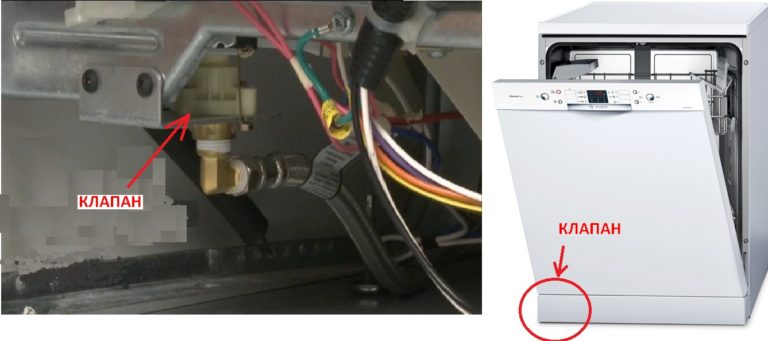
We will describe the general sequence of work:
- turn off the water supply;
- remove the bottom panel under the door;
- disconnect the inlet hose;
- behind it is a valve;
- check the electronic part of the part with a multimeter, connect the probes to the contacts and look at the value;
- if the valve is working, it will show from 500 to 1500 ohms;
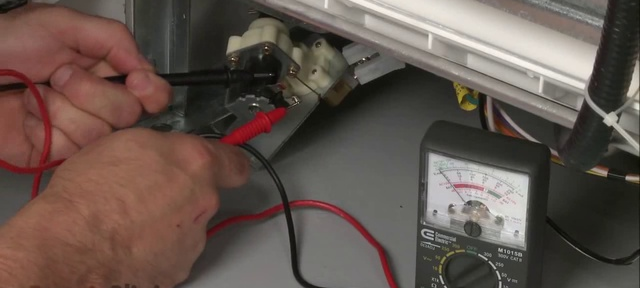
- check the mechanical part by applying a voltage of 220 V; if at the same time the membrane opens, the part is in good order;
- to replace, disconnect the hose and wiring from the valve;
- install a new item.
Water does not circulate well, problems with detergent powder
If there is a normal water intake, but the equipment does not start washing or does not wash off the dirt from the dishes, then the circulation system in the PMM is broken. Check:
- Injectors. Open the bunker, pull out the baskets. Remove the lower and upper spray arms. Clean the nozzles with a toothpick and rinse under the tap.
- Circulation pump. The machine draws water but then stops. For diagnostics, you will have to disassemble the dishwasher.
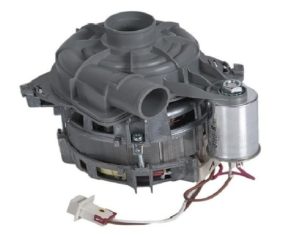
What do we have to do:
- disconnect the PMM from the network and communications;
- put in an empty space and lay an old blanket (towel);
- flip the case over to the back panel;
- remove the bottom panel under the door;
- unscrew the screws around the perimeter and remove the pallet (first disconnect the float sensor, which is located on the pallet);
- in the center you will find a circulation block;

- inspect the pump, ring the electronic part with a multimeter;
- in the event of a malfunction, you will have to completely replace the element.
If you are satisfied that the water rinses through the dishes properly, but there are streaks and food debris on the surface, check the detergent dispenser. Unscrupulous manufacturers make a cuvette from cheap material.

The plastic expands when exposed to hot steam. Therefore, the compartment is jammed. The tablet cannot dissolve normally. The way out is to replace the cuvette or adjust the compartment with your own hands.
Heating problems
Depending on the PMM device, damage can manifest itself in different ways. More modern models have a built-in temperature sensor that monitors the heating temperature.If you set the program to 70 degrees, then when the temperature is reached, the sensor sends a signal to the module, which turns off the heating element.
If the heater burns out, then the machine (Bosch, Siemens, Ariston and others) draws water, starts heating and stops. Models without a sensor continue to work with cold water, so the devices are difficult to clean.
Usually, a flow heater is installed in cars, so in case of a breakdown, you will have to change the entire unit. The sequence of work is the same as when replacing the pump. Only first you need to unscrew the fastening screws inside the camera.
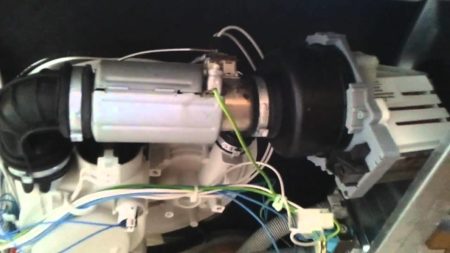
When the equipment does not turn on and does not start, the matter may be in the control module. This is the most serious breakdown that cannot be repaired on your own. The electronic board controls all processes in the dishwasher. You can check it, but it is better to entrust the repair to a specialist.
When you can't do without the help of a specialist
Above are the malfunctions that, in principle, can be eliminated with your own hands, but there are also a number of complex breakdowns. To eliminate them, you will have to contact the service department and call a specialist at home, since to perform maintenance or repairs, knowledge of the procedure for disassembling the machine and removing defective units is required. At the same time, a specialist can diagnose PMM.
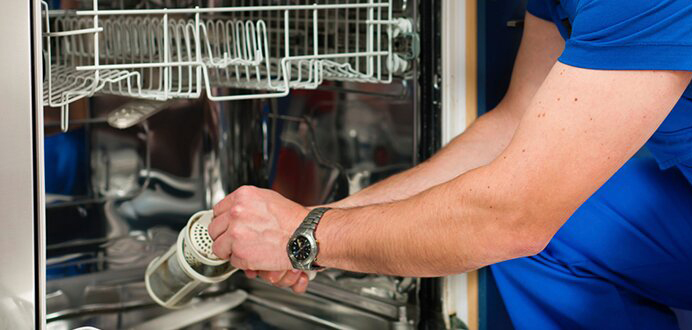 To eliminate complex breakdowns, you will have to contact the service department and call a specialist at home.
To eliminate complex breakdowns, you will have to contact the service department and call a specialist at home.
Circulation pump malfunction
If this unit breaks down, the water supply is blocked, and as a result, the dishwashing process stops. In such a situation, there is only one way out, its replacement. To maintain the efficiency of the dishwasher, it is worth installing, so to speak, a native, suitable pump.
 If the circulation pump breaks down, the water supply is blocked, and as a result, the dishwashing process stops.
If the circulation pump breaks down, the water supply is blocked, and as a result, the dishwashing process stops.
Error in the operation of the control module
The basic task of this device is to control the operation of the machine. And at the slightest malfunction, interruptions begin, etc. This problem can be eliminated only by replacing the control module.
 This problem can only be eliminated by replacing the control module.
This problem can only be eliminated by replacing the control module.
Broken recirculation pump
The task of this device is to pump water in the system and supply it to the working chamber. If it breaks down, the water pressure in the machine drops, and it stops working. The way out of this situation is quite simple, replacement or repair, but you should not do it yourself.
 If the recirculation pump breaks down, the water pressure in the machine drops and it stops working.
If the recirculation pump breaks down, the water pressure in the machine drops and it stops working.
Failure or malfunction of the software module
The memory of this device contains the programs necessary for the efficient operation of the machine. Even a small malfunction in its operation leads to errors in the program, that is, a distortion of the operating modes occurs, which will certainly affect the quality of washing kitchen utensils. What to do if the dishwasher does not wash the dishes well? There are two methods - either repairing the module, or replacing it.
 The program module of the device contains the programs necessary for the efficient operation of the machine.
The program module of the device contains the programs necessary for the efficient operation of the machine.
Burned out heating element (water heater)
Sometimes, for various reasons, the heating element stops working. As a rule, this is due to the fact that scale has accumulated on its surface. It complicates the transfer of heat, and for the full-fledged operation of the heating element, it must consume more energy. As a result, it simply burns out. This unit cannot be repaired, and therefore it is simply replaced.
 The heating element cannot be repaired, and therefore it is simply changed.
The heating element cannot be repaired, and therefore it is simply changed.
Breakage of the turbidity sensor in the dishwasher
Such an indicator is installed in advanced PMM, for example, Bosch, Indesit and other rather expensive models. Its task is to monitor water quality. When a certain level of water turbidity is reached, it transmits a corresponding signal to the controller. And if the Bosch dishwasher does not wash the dishes well because of this, then there is only one way out - replacing the sensor.
 The task of a water turbidity sensor is to monitor water quality.
The task of a water turbidity sensor is to monitor water quality.
Failure of the sprinkler impeller
The impeller is a device required for spraying water in the working chamber. If it fails, the water stops flowing in the normal mode, and the quality of washing tends to zero. Exit - change this node.
 The impeller is a device necessary for spraying water in the working chamber.
The impeller is a device necessary for spraying water in the working chamber.
Thermostat burnt out
The key mission of this indicator is to track the heating level of the water supplied to wash kitchen utensils. He transmits this information to the control unit, which decides whether to continue heating or stop. If the indicator fails, the dishes will be washed in cold water, and this will negatively affect the quality of the wash. Its replacement is required.
 If the indicator fails, the dishes will be washed in cold water, and this will negatively affect the quality of the wash.
If the indicator fails, the dishes will be washed in cold water, and this will negatively affect the quality of the wash.
If the dishwasher does not wash the dishes, it must be remembered that this is a rather complex device, and exact observance of the instructions is required during its operation. It is not worth it to replace worn out or broken units yourself, such work requires both certain knowledge and special skills. In addition, a special tool may be required that is used only for repairing PMM, and self-disassembly of machines can lead to the fact that either you have to give it for overhaul or dispose of it.
Wrong detergents
Symptoms: The quality of the wash has dropped after changing the detergent or its dosage.
Of course, the quality of washing depends on the correct choice of detergents and their dosage. We don't think it's worth explaining the obvious
truths: you should carefully read the instructions, do not buy completely cheap products, do not save on dosages and do not fall asleep too much
detergents. But even if you carefully follow all the recommendations, you are not immune from fakes, of which there are many in stores.
Popular all-in-one 3-in-1 tablets are often not as good as powder, salt, and rinse separately. First, the pill
dissolves longer and worse, and secondly, they are too universal a solution, and may not be suitable for your conditions,
for example, due to too hard water. It does not hurt to conduct an experiment comparing the quality of washing with a tablet and individual means. Can
try leaving tablets instead of powder, but in addition to them, use salt and rinse aid.
If too much foam forms in the machine, you may have overused the rinse aid: either set the dispenser to a lower flow rate, or
add more powder - it perfectly extinguishes foam.
Gray deposits and smudges on the dishes after washing may indicate a lack of rinse aid: set the rinse aid dispenser to a high flow, if necessary,
add rinse aid. White bloom may indicate a loosely closed salt lid. When tea or coffee is not washed well, possible
the reason is a low bleach content in the detergent: try a different one or use a suitable additive. Similarly, if remain
oily stains - there may not be enough fat-dissolving agents in the powder.


